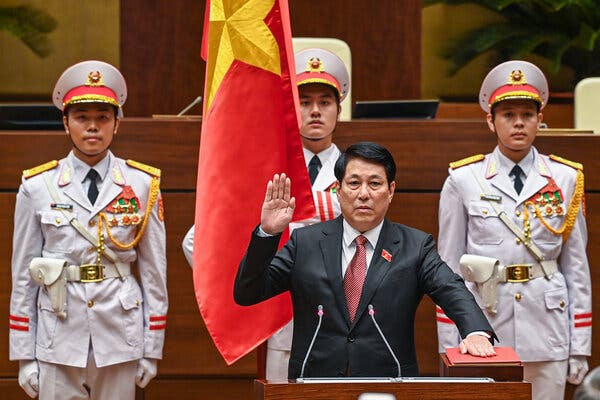The move restores a “four pillar” government structure that divides top-level duties to avoid the rise of a single strongman.

Vietnam’s National Assembly approved a new president on Monday, restoring a power-sharing arrangement among four high-level leaders that has defined the country’s approach to Communist government for decades.
The assembly’s announcement that Luong Cuong, a Vietnamese Army general, would be president calms speculation about the country’s top leader, To Lam, and whether he would try to retain the presidency after rising to become general secretary of the Communist Party in August.
Under the country’s “four pillar” structure, established in part to avoid the rise of a single strongman, decision-making roles are split among the general secretary, president, prime minister and head of the National Assembly.
Vietnam’s president typically oversees the military and usually comes from within its ranks. But from 2018 to 2021, Nguyen Phu Trong, who was general secretary from 2011 until his death in 2024, also served as president.Mr. Lam had been named president in May and initially held both roles. As minister of public security before that, he helped lead an anti-corruption campaign that pushed out several high-level figures, including two presidents and three deputy prime ministers.
It was unclear whether he would seek to keep two positions and consolidate power ahead of the National Party Congress scheduled for 2026, when the country’s next leaders will be chosen.
In a speech opening the assembly’s session on Monday, Mr. Lam praised his Communist Party colleagues for reaching an agreement at a moment when “the global and regional situation has had many complex developments, with unprecedented and unpredictable issues, posing many significant challenges to the task of building and defending the nation.”
“The passing of comrade general secretary Nguyen Phu Trong is a great loss, leaving deep sorrow among the people and soldiers across the country,” he said. “In this context, our party has shown steadfast resolve, maintaining a unified bloc in will and action, quickly consolidating the leadership of the party and state with high consensus.”
In his own introductory speech, Mr. Cuong promised to “resolutely and persistently safeguard national independence, sovereignty, unity and territorial integrity.”
Analysts said a return to Vietnam’s four-pillars arrangement could help minimize political infighting as another generation of leaders seek to fulfill Vietnam’s long-held ambitions of becoming a wealthy nation with high-end manufacturing and a larger role on the world stage.
“This could help mitigate factional tensions by ensuring that the military has a prominent role in the nation’s leadership,” said Nguyen Khac Giang, a visiting fellow at the ISEAS-Yusof Ishak Institute, a research organization in Singapore.
He added, “This will help stabilize the system after a period of significant turbulence.”
Damien Cave is an international correspondent for The Times, covering the Indo-Pacific region. He is based in Sydney, Australia. More about Damien Cave
See more on: Communist Party of Vietnam